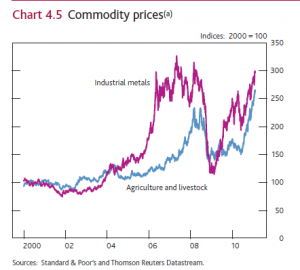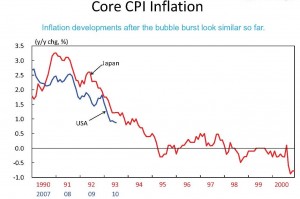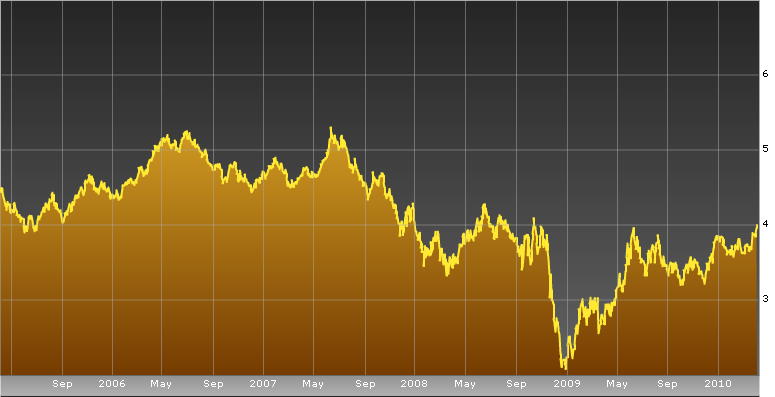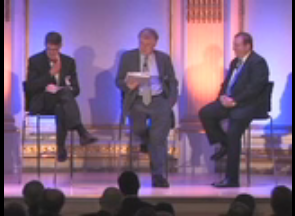Home » Posts tagged 'Inflation'
Tag Archives: Inflation
Meltzer – US inflation is coming
Interview of Allan Meltzer, the outspoken historian on the Fed:
Bridgewater’s Dalio on Investment Outlook
Ray Dalio, founder & CIO of Bridgewater Associates, runs the world’s largest hedge fund with $89 billion under management, returning more for the fund’s investors last year than Google, Amazon, Yahoo and eBay combined.
In this CNBC interview, Dalio shares his view on the US dollar, world investment outlook, the ongoing great deleveraging and the great divergence between the developed vs. developing world.
Maybe “stagflation” is for real…
Yield curve is telling a very different story than the stock market. Echoing Meltzer’s earlier piece, “Bernanke’s 70s show“, maybe stagflation is for real…reports WSJ:
Treasurys may be signaling trouble.
The market is behaving in ways that suggest investors are starting to fret over the potential for stagflation in the U.S. …
Consider the Treasury “yield curve.” It refers to the difference between short-term and long-term interest rates on U.S. Treasury debt. Typically, as the economy is expanding, this curve has an upward slope, and is usually at its steepest during the earliest stages of a recovery.
Eventually, investors anticipate the Fed will begin raising interest rates to stave off inflation. That tends to lift short-term rates, compress long-term ones, and generally flatten the curve, or even invert it if investors expect the outcome could be recession.
Lately, with the U.S. growth outlook improving, the slope of the curve hasn’t started flattening, as might be expected at this point in the recovery. Instead, it has gotten steeper.
Earlier this week, the spread between two-year and 30-year Treasury yields hit a record-wide four percentage points, notes RBS Securities. At the same time, the implied annual inflation rate over a five-to-10 year horizon, based on Treasury yields, has moved up above 3% and towards levels last seen before the Fed’s previous rate-rise cycle began in mid-2004.
Investors, in other words, don’t expect the Fed to be as aggressive as in the past in raising rates—even as they see inflation on the rise.
“I think the Fed’s credibility is in question here,” says Priya Misra, head of rates strategy at Bank of America Merrill Lynch.
Or perhaps investors simply realize the Fed has put itself between a rock and a hard place. The U.S. unemployment rate is currently 9.4%, after all. It was at 5.6% in June 2004.
In a twist, the best scenario for the U.S. now is that interest rate increases in China, Brazil and other emerging markets rein in global cost pressures, giving the Fed—and the recovery—some breathing room.
The U.S. needs strong growth more than ever, especially with limited appetite for serious fiscal overhaul, to assuage the market’s other worry: wide deficits and heavy debt.
The clock is ticking.
America’s new export – Inflation
It’s the replay of 1H of 2008, only with more severity. If were not for Lehman’s collapse, the prices of commodities would have shot to the roof more than two years ago. Now the still-the-same super easy monetary policy made commodity prices, especially food prices, come back again, evident everywhere in the world.
(click to enlarge, source: BOE)
China just reported its latest CPI number of close to 5%, but food prices jumped over 10% year over year. The food inflation forced China’s Bureau of Statistics to adjust down the weight of food in the CPI calculation. Isn’t this ridiculous! — The government wanted to you to believe as if inflation does not exist!
At the same time, various signs show that the huge excess reserves are being gradually unleashed from banks’ balance sheets — one indicator is that the yield on junk bonds has almost reached historical lows; another sign is that banks now started to relax their lending standards to both consumers and small businesses.
What we are seeing is exactly the divergence of traditional inflation measure (CPI) and asset inflation. Let’s call it “biflation”.
(click to enlarge, source: BOE)
Ronald McKinnon, an expert of exchange rate and US dollar at Stanford University, labels inflation as America’s latest export:
What do the years 1971, 2003 and 2010 have in common? In each year, low U.S. interest rates and the expectation of dollar depreciation led to massive “hot” money outflows from the U.S. and world-wide inflation. And in all three cases, foreign central banks intervened heavily to buy dollars to prevent their currencies from appreciating.
When central banks issue base money to buy dollars, domestic interest rates are forced down and domestic inflationary pressure is generated. Primary commodity prices go up quickly because speculators can easily bid for long positions in organized commodity futures markets when interest rates are low.
The world saw a surge in the dollar prices of primary commodity prices in 1971-73 following the Nixon shock of 1971 when the U.S. abandoned the gold standard. There was also a commodity price surge during the Greenspan-Bernanke shock of 2003-04, when the federal-funds rate was reduced to an unprecedented low of 1% followed by a falling dollar.
Now we have what one might call the Bernanke shock. The Fed has set U.S. short-term interest rates at essentially zero since September 2008, followed in 2010 by quantitative easing to drive down long-term rates. Predictably, primary commodity prices in 2009-10 surged. In 2010 alone, all items in the Economist’s dollar commodity price index rose 33.5%, while the industrial raw materials component soared a remarkable 37.4.%.
The longer-term inflationary and economic consequences over the next decade of this most recent U.S. loose money shock remain to be seen. But we can glean useful hints by looking at the aftermaths of the two earlier shocks. In the 1970s, “stagflation” (inflation combined with cyclical bouts of unemployment and wide swings in exchange rates) seemed intractable. Productivity growth in mature industrial countries fell sharply.
…
The Greenspan-Bernanke interest rate shock of 2003-04, followed by a weakening dollar into the first half of 2008, created the bubble economy. Primary commodity prices began rising significantly in 2003-04, then flattened out before spiking in 2007 into the first half of 2008.
But the biggest bubble was in real estate, both commercial and residential. With low mortgage rates and no restraining regulation on mortgage quality, average U.S. home prices rose more than 50% from the beginning of 2003 to the middle of 2006. This led to an unsustainable building boom—with echoes around the world in countries such as the U.K, Spain and Ireland. The bubbles in primary commodity prices collapsed mainly in the second half of 2008. But the residue of bad debts, particularly ongoing mortgage defaults, led to the banking crisis and global downturn of 2008-09.
So what lessons can we draw from these episodes of U.S. easy money and a weak dollar for the stability of the American economy itself?
First, sharp general price increases in auction-market goods such as primary commodities or foreign exchange (i.e., a weakening dollar) is an early warning sign that the Fed is being too easy—a warning that the Fed is again ignoring as we enter 2011.
Second, beyond the rise in primary commodity prices, general price inflation in the U.S. only comes with long and variable lags. After the U.S. monetary shock, hot money flows into countries on the dollar standard’s periphery cause a loss of monetary control and general inflation to show up there more quickly than in the U.S.
In 2010, consumer price indexes shot up more than 5% in major emerging markets such as China, Brazil and Indonesia, while the consumer price index in the U.S. itself rose only 1.2%. Similarly, after the Nixon shock of 1971, there was much more explosive inflation in Japan in 1972-73 than in the U.S. But by December 1979, inflation in America’s producer and consumer price indexes was more than 13%.
Andy Xie on China’s inflation outlook
Interview of Andy Xie, former Morgan Stanley Chief China economist.
Pay attention to his view that raising interest rate will have limited effect on containing inflation because it may prick the housing bubble. This is especially true when considering local governments’ huge stake in keeping housing and land prices high.
I expect Chinese government will resort more to raising bank reserves and administrative measures to contain inflation.
Three other things are also likely to happen:
1) Chinese government may distort official inflation numbers, i.e., more human smoothing.
2) Accelerate Yuan’s appreciation, which I think is most likely. In fact, Qing Wang of Morgan Stanley expects the RMB to appreciate from currently 6.64 to 6.2 by Dec. 2011. Marty Feldstein, in my earlier post, echoed the similar view.
3) tighter capital control to prevent inflow of hot money.
More broader picture is that the super easy monetary policy by the Fed is propping asset bubbles everywhere in the world, especially in the fast growing emerging economies (carry trade factor). Besides China, Brazil also faces grim inflation outlook, and Brazilian interest rate is already above 10% and expected to rise further.
Commodity prices are already high and fast rising. But given the debasement of paper currency across board, and the grim inflation outlook in emerging markets, it’s reasonable to believe commodities are set to rise further.
Higher volatility is ahead of us; expect to see more booms and busts; and China is facing another real challenge.
US vs Japan: so far not much difference
Deflation watch continues. The following graph from Bank of Japan is the most damaging chart I’ve seen for a long while (hat tip to John Taylor and his blog).
US policy makers still have chance to revert the course. But so far, they just look all too similar.
(click to enlarge; source: Bank of Japan)
Deflation Threat: Is America another Japan?
Does America face Japanese-style deflation?
Treasury current is shifting, part 2
From WSJ (April 5, 2010):
The 10-year Treasury yield, the benchmark for U.S. consumer and corporate borrowing, rose to 4% for the first time since June.
The move extends a steady increase by Treasury yields, which move inversely to prices, lifted by a combination of stronger economic data and the barrage of debt issued by the government to meet its financing needs. Recent Treasury auctions have met with much weaker demand and Monday’s move comes ahead of more auctions this week, with the Treasury Department set to sell $82 billion of Treasury notes and bonds.The 10-year yield is a key benchmark for mortgage rates and other consumer and corporate lending.
My best take on the surge of 10-year rate is: this is due to more of investors’ early worry about US fiscal situation and rising long-term inflation expectation; rather than expectation of strong economic recovery.
Remember, the Fed can’t directly control long-term interest rate. IF the 10-y rate continues to rise as the result of rising inflation expectation, the Fed will be forced to raise short-term interest rate. This will put a brake on the tepid economic recovery, potentially causing a double-dip scenario, like the recession in 1981.
Now watch this great debate on the issue, between Jim Grant and Dave Rosenberg, on the topic whether “Treasury is for losers”…
Jim Grant holds the view that high inflation is ahead of us, and Rosenberg thinks deflation is a bigger risk, so treasury/bond securities are not bad bet.
(click to play, about 50 mins)


![[AOT]](https://si.wsj.net/public/resources/images/MI-BH984_AOT_NS_20110120183303.jpg)




